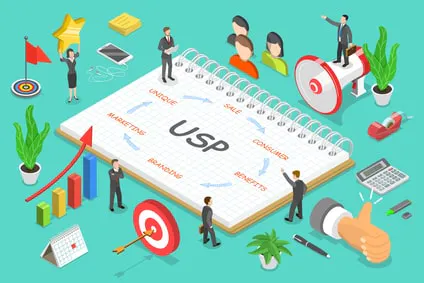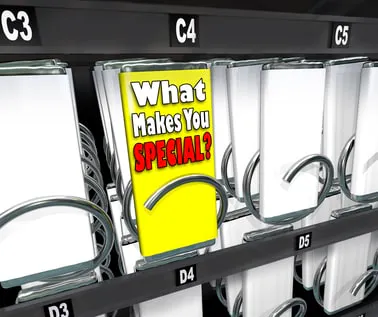Does your product stand out in a crowded marketplace … or do your prospective customers think it’s basically the same as what your competitors are offering?
A unique selling proposition (sometimes also called a “unique selling point”) lets you cut through the noise and show how your product or service is different.
Your USP is what makes you stand out from the crowd, and it’s often what prospective customers remember when they’re ready to come back to your website and buy.
So what exactly does a unique selling proposition look like?
Understanding the unique selling proposition

Your unique selling proposition might be something like:
- Lowest price: if you can undercut your competition, that’s a powerful way to stand out. This is very hard to manage, though, in a marketplace where a lot of large companies are competing on price.
- Highest quality: maybe you charge a premium price … but your product or service is really good. Think of a brand like Starbucks: they don’t attempt to make their coffee the cheapest out there, but they’re known for consistent quality.
- Strong branding: a fun, irreverent, or otherwise “different” voice can make your brand instantly more engaging and interesting. Convince & Convert has some great examples of this here.
- Great customer service: Zappos built their name on this. If you’re in an industry where customer service tends to be mediocre at best, then focusing on this could make you memorable for all the right reasons.
- Long-established. If your company has been around for many years, then you could focus on this as your USP – it demonstrates lots of experience and reassures customers that if you’ve been around that long, you’re not about to disappear overnight.
Important: Your USP should be one thing … not several. Don’t try to offer the “highest quality at the lowest price”, because you’ll have to compromise on one or the other. You’ll also dilute the power of your message by cramming too much in.
Three questions to help you find your unique selling proposition

What if you don’t have an obvious USP? Perhaps your product or service is perfectly good … but there’s nothing that makes it really stand out.
As a marketer, you might be tempted to “force” a USP: to pick something and add it into your company’s branding. But ideally, you want your USP to arise from what you’re already doing. There’s almost certainly something you could build on.
Here are some questions to ask yourself:
#1: What do your existing customers praise?
Take a look at the testimonials and emails you’ve had from previous customers, and leverage social listening tools to tap into discussions around the web. What do they pick up on about your brand? Maybe several people mention the “great communication” from your customer service team, or the “really fast shipping” of your products.
You may find that customers spot something you’d take for granted, like your company’s dedication to detail, or your well-designed client intake processes that run without the hitch. Could you build on this to create a USP?
#2: What are your colleagues proud of?
What do your colleagues (particularly those who interact directly with customers) like best about your brand? Perhaps it’s knowing that they’re offering a really high-quality service – rather than trying to serve as many people as possible at the lowest prices. Or maybe it’s the flexibility they have to offer discounts or bonuses for customers.
By finding out what your colleagues love most about your brand, you can again start to spot potential USPs that you could use in your marketing.
#3: How are you different from your competitors?
Write down the names of your top 5 – 10 competitors, and add the key words or phrases that come to mind for each. (For instance, one competitor might be “long-established but products are getting dated” and another might be “cheap but known for poor customer service.”)
How are you different? What do you have that stands out from all your competitors? Maybe it’s your fantastic money-back guarantee, your high-quality design, your friendly, approachable tone, or the specific audience you focus on serving. Could this become your USP? In this post, we offer more helpful tips for conducting a SWOT analysis.
Using your unique selling proposition
Once you have a clear USP, you need to make sure you communicate it to your customers. This isn’t just a case of coming up with a great tagline (though if that’s what you’re struggling with, there are some great examples here).
It’s also about communicating your USP through every aspect of your brand, including:
Your design choices. If your USP is that you’re a young, dynamic, fun company, that’s not going to come across if your website is in a dull corporate blue with lots of bland stock photos. (Looking for some easy-to-use tools to create custom images? Check out our list of the best free image creators for marketers.)
Your communication with customers and potential customers. If your USP is that you’re highly responsive and helpful, it won’t look good if your customer service team takes days to reply to emails, or if they’re overly reliant on scripts so they sometimes fail to actually address the problem at hand.
Your social media channels. If “close attention to detail” is part of your USP, then you don’t want to be sending out social media posts with poor spelling or grammar. Whatever your USP, you also want the material you share or retweet to tie in with it. (Check out this post for tips on optimizing your social media posts.
Crafting a USP can be tricky, and drawing it out fully within your brand could take a while, but the results – customers who keep coming back, and prospects who remember you and are drawn to you – are well worth the effort.
Creating a compelling unique selling proposition piques interest among potential customers. Make it easy for them to learn more about your brand and stay in touch by installing social media follow buttons on your blog or website. They’re free and easy to install, and most importantly, they make it simple for your visitors to follow you instantly on their favorite social networks with just one click.




